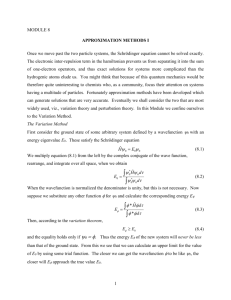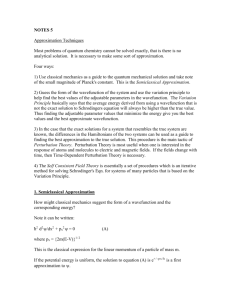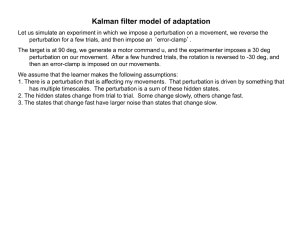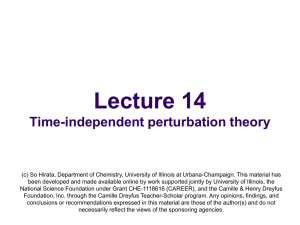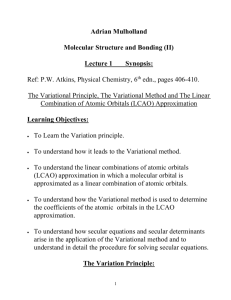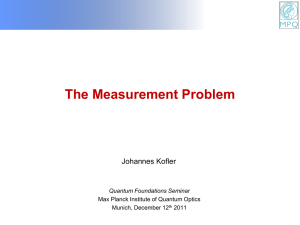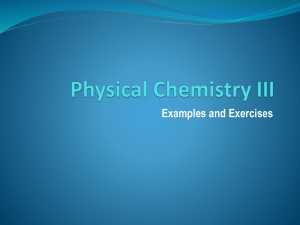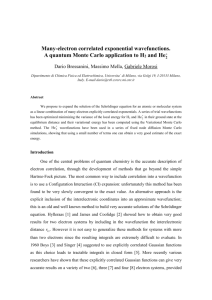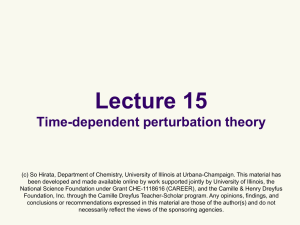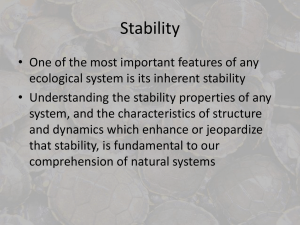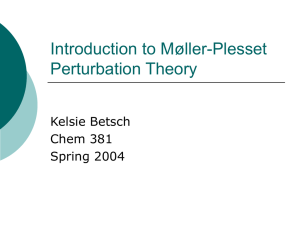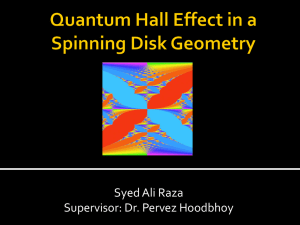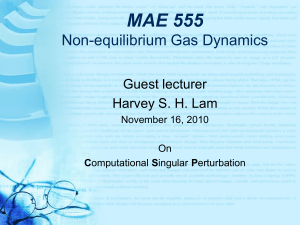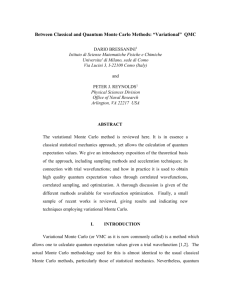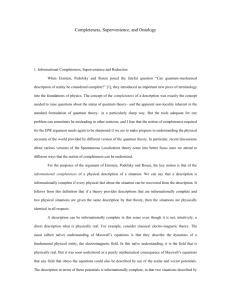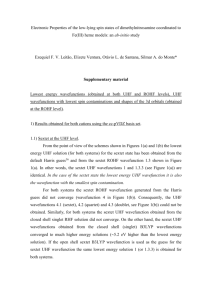doc
advertisement
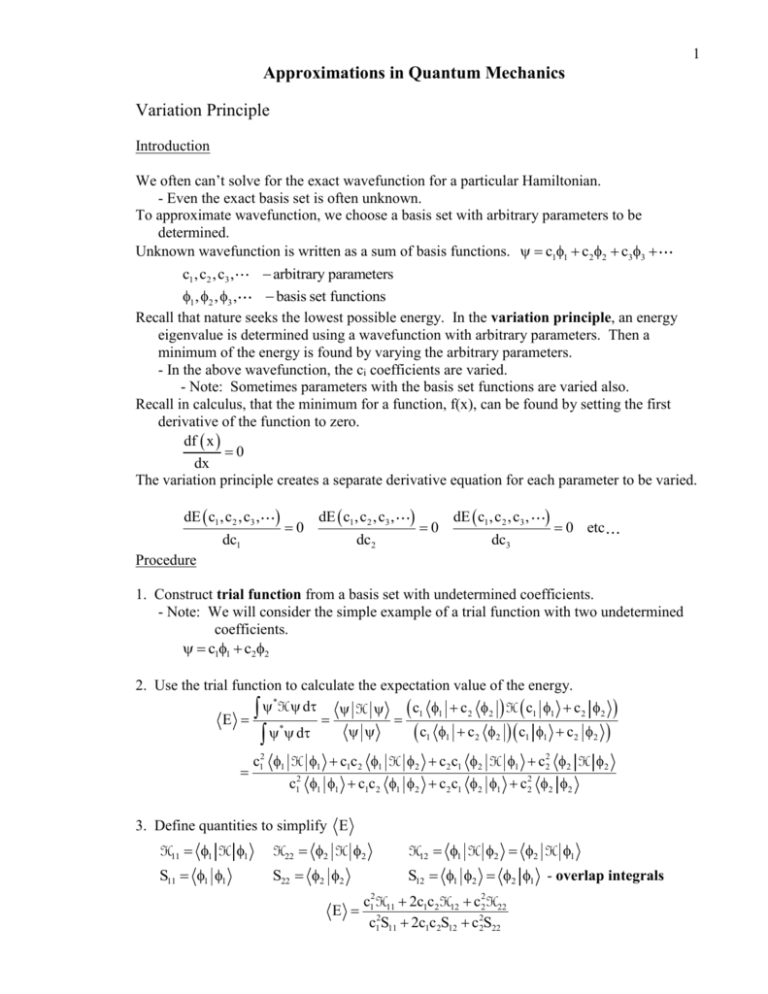
1 Approximations in Quantum Mechanics Variation Principle Introduction We often can’t solve for the exact wavefunction for a particular Hamiltonian. - Even the exact basis set is often unknown. To approximate wavefunction, we choose a basis set with arbitrary parameters to be determined. Unknown wavefunction is written as a sum of basis functions. c11 c22 c33 c1 ,c2 ,c3 , arbitrary parameters 1 , 2 , 3 , basis set functions Recall that nature seeks the lowest possible energy. In the variation principle, an energy eigenvalue is determined using a wavefunction with arbitrary parameters. Then a minimum of the energy is found by varying the arbitrary parameters. - In the above wavefunction, the ci coefficients are varied. - Note: Sometimes parameters with the basis set functions are varied also. Recall in calculus, that the minimum for a function, f(x), can be found by setting the first derivative of the function to zero. df x 0 dx The variation principle creates a separate derivative equation for each parameter to be varied. dE c1 , c2 , c3 , dc1 Procedure 0 dE c1 , c 2 , c3 , dc2 0 dE c1 , c 2 , c3 , dc3 0 etc 1. Construct trial function from a basis set with undetermined coefficients. - Note: We will consider the simple example of a trial function with two undetermined coefficients. c11 c22 2. Use the trial function to calculate the expectation value of the energy. *H d H c1 1 c2 2 H c1 1 c2 2 E * c1 1 c2 2 c1 1 c2 2 d c12 1 H 1 c1c 2 1 H 2 c 2 c1 2 H 1 c22 2 H 2 c12 1 1 c1c 2 1 2 c 2 c1 2 1 c 22 2 2 3. Define quantities to simplify E H11 1 H 1 H22 2 H 2 H12 1 H 2 2 H 1 S11 1 1 S22 2 2 S12 1 2 2 1 - overlap integrals E c12H11 2c1c 2H12 c 22H22 c12S11 2c1c2S12 c 22S22 2 4. Multiply the energy expectation value by denominator of expression. c12S11 2c1c2S12 c22S22 E c12H11 2c1c2H12 c22H22 5. Take derivative of expression with respect to coefficient using implicit differentiation and set derivative equal to zero. E - find c1 2c1S11 2c2S12 - remember E c12S11 2c1c 2S12 c 22S22 E 2c1H11 2c 2H12 c1 E 0 c1 2c1H11 2c2H12 2c1S11 2c 2S12 E 0 c1 H11 ES11 c 2 H12 ES12 0 - for E c 2 E c1 H12 ES12 c2 H22 ES22 0 c2 6. Rearrange two equations in two unknown as a matrix equation. H11 ES11 H12 ES12 c1 0 H12 ES12 H22 ES22 c2 7. Solve secular determinant to find E eigenvalues. H11 ES11 H12 ES12 H12 ES12 H22 ES22 0 2 H11 ES11 H22 ES22 H12 ES12 0 2 2 2 S11S22 E 2 H11S22 H22S11 E H11H22 S12 E 2H12S12 E H12 0 S S 11 22 E 2 S12 E2 H11S22 H22S11 2H12S12 E H11H22 H122 0 H11S22 H22S11 2H12S12 H11S22 H22S11 2H12S12 2 2 S11S22 S12 2 2 4 S11S22 S12 H11H22 H122 c 8. Use E eigenvalues to find eigenvectors, 1 which are the coefficients of the optimized c2 trial function. The optimized trial function is the approximate wave function for which we have been searching. 9. The optimized trial function now may be used to calculate other properties. - note: Energy is already calculated. 3 Perturbation Theory Introduction/Motivation In the beginning of studying quantum chemistry, the problems considered are relatively easy to solve (believe it or not). The simple problems have closed, analytic solutions, that is, the solution are expressed as relatively simple functions. However, not all problems have nice, neat answers. Consider hydrogen atom in an electric field Without electric field, the ground state electronic orbital is a 1s, which is spherical. The wavefunction and the energy of the system is known exactly. Consider what happens when an electric field is applied to the hydrogen atom. + - Now how does one describe the electronic orbital? How does one determine the energy? The problem can be solved using techniques from perturbation theory. perturbation – disturbance, stress, shock, etc… General Perturbation Theory Assumptions of perturbation theory 1. The Hamiltonian can be written as a series in terms of an arbitrary parameter, and 1 2 perturbations, H , H . H H H 2H 2. The wavefunction can be written as a series in terms of an arbitrary parameter, and 1 2 corrections, , . 0 1 2 2 3. The energy can be written as a series in terms of an arbitrary parameter, and corrections, 1 2 E , E . 0 1 2 E E E 2E 0 1 2 4 The parameter indicates the strength of the perturbations, e.g., the strength of the electric 1 H field. The above assumptions are very good as long as 1 i.e. 1 In other 0 H words, the perturbations have to be relatively weak. General method To find the energy and wavefunction corrections, equations need to be developed by H = E substituting the series approximations into the Schrödinger equation. H H H E E E 0 1 2 2 0 1 0 2 2 1 2 2 0 0 1 0 2 2 E E E E E E H H H 2 H H H 0 1 0 1 0 2 0 0 1 1 0 0 1 0 1 2 2 2 0 1 1 0 2 For the equality to hold for any , i.e., any strength of perturbation, each “coefficient” of terms must be equal. 0 0 0 0 For 0 H E - zeroth order, unperturbed Schrödinger equation 1 0 0 1 1 0 0 1 For 1 H H E E For 2 H H H E E E 2 0 1 1 0 2 2 0 1 1 0 2 First Order Perturbation Theory H E H E The 1 equation rearranged becomes 0 0 1 1 1 0 1 1 1 This equation becomes useful, if we can solve for and E . Note that H is given, it is the perturbation. 1 To solve we need to assume a form for the corrected wavefunction, . a n n 1 an – coefficients to be calculated n n – wavefunction from basis set of “zeroth-order” Hamiltonian. - e.g., harmonic oscillator wavefunctions, hydrogenic atom wavefunctions, spherical harmonics, etc… First-order perturbation energy Substitute assumed series form of corrected wavefunction into first-order perturbation equation. H E a a H E n H E 0 0 0 n n 0 n n H E 0 1 n 0 1 1 1 5 Now allow the zeroth-order Hamiltonian to operate on n . a n H E n H E 0 a E E n H E 0 0 0 1 1 n 1 n n 1 0 n Note that because of the basis set we have chosen, E 0 E0 and 0 0 (i.e., *0 ) and integrate. Now multiply the equation by 0 0 a E n n n a E n E0 n 0 H E 0 1 1 n E0 0 n 0 H 0 0 E 0 n E 0 0n 0 H 0 E 1 1 n a E n 1 1 n Now taking the sum on the left-hand side, note that 0n for all n 0. 1 1 a 0 E0 E0 0 H 0 E 0 0 H 0 E 1 1 The first-order correction to the energy is E 0 H 0 1 1 Thus to calculate the first-order correction to the energy, all that is needed is the zeroth-order ground state wavefunction and the first-order perturbation. This is remarkably simple! First-order perturbation wavefunction To calculate the first-order correction to the wavefunction, we need to calculate the an coefficients. Return to a E n n E 0 n H E 0 n 1 1 (i.e., *k ) and integrate. We will be Now multiply the equation by an arbitrary state, k careful not to allow the state to be the ground state, i.e., k0. k a E n n n a E n E0 n k H E 0 1 1 n E0 k n k H 0 k E 0 n E 0 kn k H 0 E k 0 1 1 n a E n n 1 1 6 Now taking the sum on the left-hand side, note that kn = 1 only when k=n. Also note that k0 = 0 a k Ek E0 k H 0 1 k H 0 ak Ek E0 1 Another relatively simple result! Therefore the first-order correction to the wavefunction is k H 0 a k k k k k Ek E0 Notation: The prime on the summation symbol indicates to take the sum over all possible k except k = 0, i.e., don’t include the ground state. 1 1 The total wavefunction including the first-order correction is k H 0 0 a k k 0 k k k Ek E0 Without using bra-ket notation, the total wavefunction is 1 *kH 0d 0 1 0 a k k 0 Ek E0 k k k Interpretation of results 0 1 1 Perturbation has the effect of adding to the zeroth-order wavefunction, excited state wavefunction, i.e., the excited state wavefunctions “mix” with the ground state wavefunction. Also, one can consider that the perturbation has induced “virtual” transitions to excited states. Second Order Perturbation Theory 2 0 1 1 0 2 2 0 1 1 0 2 The 2 equation is H H H E E E Rearranged, the equation becomes 0 0 2 1 1 1 2 2 0 H E H E H E To solve we need to assume a form for the corrected wavefunction, . 2 b n n 2 bn – coefficients to be calculated n Substitute into second-order perturbation equation. H E b 0 0 n b E n n n n n H E H E 1 1 1 2 E0 n H E H E 1 1 1 2 2 2 0 0 Substitute first-order correction to the wavefunction, b E n n E0 n H E n 1 1 a n n H E n 2 2 7 1 0 Multiply equation by 0 and integrate. 0 b E n n E0 n 0 H E n b E n b E n n 1 a n n 0 H E n 1 n 2 E 0 0n a n 0 H n a n E 0n 0 H 1 n E 0 E 0 a n 0H 2 0 0 E 2 00 n 1 n 2 E 0 0 n a n 0 H n a n E 0 n 0 H 1 n n 1 2 0 E 00 2 n 1 1 n a 0E 0 H 2 0 E 2 n E 2 a n 0 H n a 0 E 0 H 1 1 2 0 n At this point, substitute for an remembering that a0 = 0 Second-order perturbation energy Often H 2 is zero, i.e., we don’t consider a second-order perturbation. Therefore the second-order correction to the energy is E 2 0 H n n H 0 2 0 H 0 En E0 n 1 1 Interpretation of results Thus to calculate the second-order correction to the energy, all of the zeroth-order excited state wavefunctions must be known. As a practical matter, often only the first few excited states are needed.
